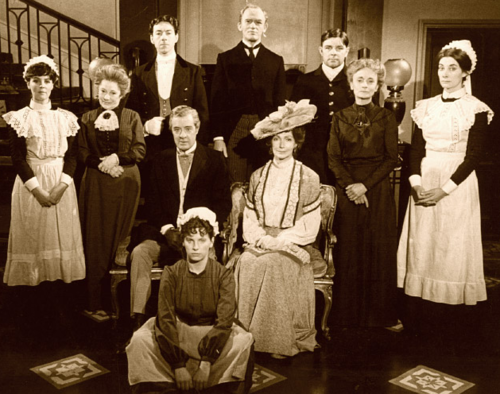A Downton Abbey Fan Watches Upstairs, Downstairs

Downton stands on Upstairs, Downstairs’ shoulders. For younger Downton fans who have never seen the 70’s classic, a Netflix Instant marathon of Upstairs is a great way to pass the time until PBS debuts Series 3 of Downton on January 6. [Cast photo courtesy of Upstairs, Downstairs Webpages]
Each Upstairs episode is about 50 minutes long. However, some early episodes were released only in black and white due to production strikes. Some episodes were recolored later on, others were left as is. Oddly enough the lack of color adds to the old-timey charm of the series. Fans new to Upstairs, Downstairs will find a lot to like. Interpersonal drama and conflict drive the episodes. Shippers will find plenty of subtext and canon to latch onto. The plot pacing is a bit faster than Downton, but still easy to follow. Usually several months pass between each episode, however, the opening credits keep the viewer aware of the month and year.
For those who love fashion and costuming, there are many styles to keep you entertained. Upstairs Series 1 shows a lot more of the Edwardian Era, which is a nice benefit for history buffs. Most of the characters have more than one dimension of personality, so there’s plenty for fans to adore and loathe. The acting, writing, and directing is top notch, which led to critical acclaim and awards on both sides of the Atlantic.
It is important to note that there are enough differences between Upstairs and Downton to refute claims of Downton being a wholesale ripoff of Upstairs. Those who judge Upstairs based only on the 2010 reboot will get an entirely inaccurate picture of the entire series. The original Upstairs was a game changer, so it is easy to see some tropes and themes reappear in productions that followed.
Upstairs, Downstairs revolves around 165 Eaton Place; the Edwardian London residence of Richard and Marjorie Bellamy. Richard is a Conservative MP, and politics of the day often show up in the plot of the show. Marjorie is a well to do heiress with important political and social connections. Their children, James and Elizabeth also live in their house. A crew of around 8 servants attend to the Bellamy household. The first season starts in November 1903 and ends in June 1909, so a direct historical portrayal comparison to Downton is imposible for now.
Richard and Marjorie have more differences compared to Robert and Cora. Marjorie’s family has firmly British elite roots, which is a stark contrast to Cora’s rich outsider status. The Crawleys are Earls and landholders, while Richard’s position as MP disappear the second election results go the wrong way. Robert and James have a similar military background despite the age gap. The Bellamys have less interaction with their extended family in Series 1 compared to the Crawleys. Friends and distinguished guests more often come to call at 165 Eaton.
The inheritance dispute pivotal to the Downton plot is not a factor at this point. James is the Bellamy heir and therefore does not have anything in common with Series 1 Downton characters. Elizabeth is close in age to Edith or Mary but she acts a lot more like an irresponsible teenager than the Crawley sisters. Her political ideas are even more progressive than Sybil’s, and she turns her words into action.
The staff in Series 1 consists of a valet (Hudson), cook (Mrs. Bridges), footman (Edward), coachman (Pierce) a head house parlourmaid (Rose), and few lower level maids (Sarah, Emily, Alice, Roberts, and others). The downstairs bureaucracy seen in Downton is a lot more fluid in Upstairs. Often servants are asked to fill multiple roles because 165 Eaton is a lot smaller than the Abbey and the surrounding countryside. The roles and personalities of Carson and Mrs. Patmore match up quite closely to Hudson and Bridges. Rose and Anna also have a lot in common. The junior maids and footmen of Upstairs aren’t as easy to compare, especially when personality is taken into consideration.
Closer quarters in 165 Eaton naturally lead to more interactions between the classes. On more than one occasion servants discussed extremely personal problems affecting their employment with either Marjorie or Richard. On two occasions Richard had to use his influence to get staff members out of trouble with the police. Rose becomes one of Elizabeth’s closest friends. In Series 1 of Downton, most of the problems of lower level servants are filtered through Carson and higher level staff upstairs.
Discussions about societal roles and challenges to the existing order are a lot more pervasive in Series 1 of Upstairs compared to Downton. The servants and the Bellamys mingle with rich and poor alike. Controversial issues such as rape, abortion, and socialism are also featured in much greater detail in Upstairs, Downstairs. In comparison, Downton is isolated in the countryside. Their interactions with other societal classes are more limited. Radical ideas at Downton are filtered through books and Branson. It should be noted that Branson’s pet issue is only mentioned once in Series 1 of Upstairs, Downstairs.
I believe watching Upstairs, Downstairs allows you to understand Downton Abbey better. You can see some of the material the writers are drawing inspiration from. Don’t believe people who say you have to choose between Upstairs and Downton. It’s very easy to like both. Whenever I finish Series 2 I’ll post another side by side review.